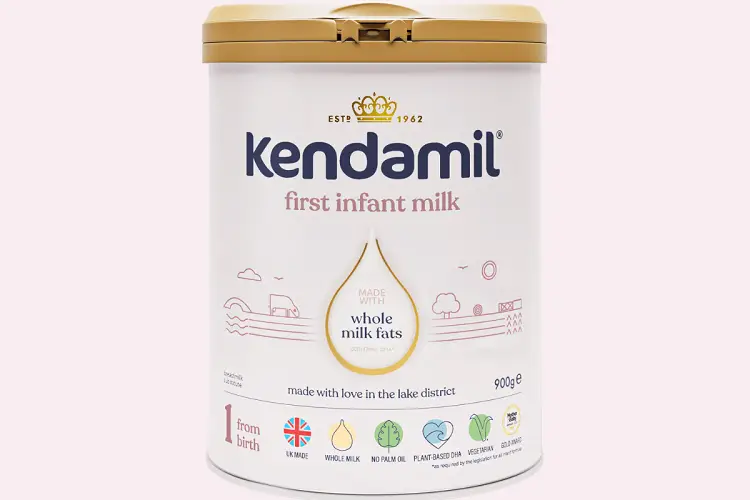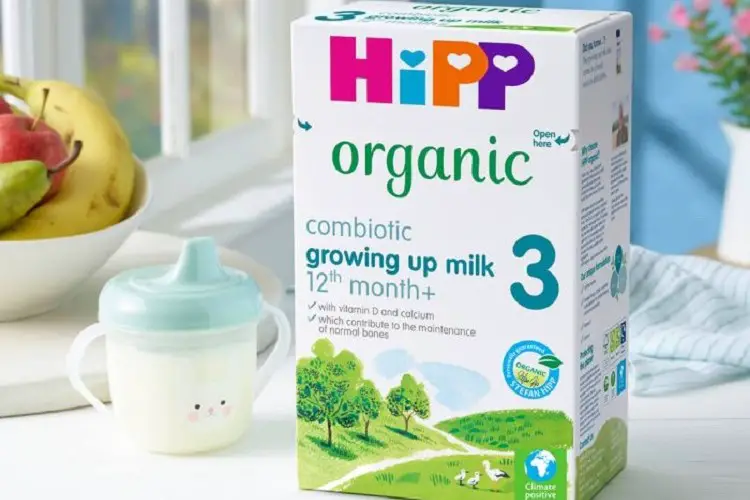Not every parent has the time to juggle between nursing and researching which formula is best between Kendamil Vs Hipp.
Kendamil is an organic formula that meets all the European and British Soil Association requirements for standard formulations but may include lapses that HiPP makes up for, and each brand is unique in terms of its ingredients, origin, and nutrients present.
To help you make more informed decisions, we have compiled a detailed comparison of both brands and drawn a verdict on which formula is the better.
Table of Contents
- Kendamil Vs HiPP
- Differences Between Kendamil Vs HiPP
- Other Alternatives to Kendamil Vs Hipp
- FAQS
- Kendamil Vs HiPP – Final Verdict
- Conclusion
Kendamil Vs HiPP
Deciding which formula to choose between Kendamil Vs HiPP is not a walk in the park for many parents.
The long list of ingredients overemphasized nutritional value, and many regulations can sometimes be confusing for parents who make time to research these products.
Other parents don’t have the luxury of time to research by themselves.
But to make a better decision, one needs access to the right information about these formulas based on their ingredients, honest user reviews, pros vs. cons, and alternative suggestions, if any.
To start on a clear note, consider each brand individually to be able to have a more accurate picture of what they have to offer.
Kendamil

Kendamil is a lead manufacturer of safe, healthy, organic baby formula. It sources its whole milk and other animal products from organically fed cows raised in humane and safe conditions.
The animals are bred in Yorkshire, Kent, and Somerset, while their plant-based ingredients are imported from accredited farms in Cumbria and Lancaster.
Kendamil baby formula is strict with ensuring child safety by adhering to and meeting all regulatory guidelines, including British Soil Association.
A charity association working to regulate and transform what and how Britain eats, farms, and cares for the natural world. It is the only formula used by the British royal family.
Each of their ingredients is strategically chosen and screened to fit pediatrician approval.
The ingredients include lactose, prebiotics, and whole milk, which are natural sweeteners. Other macronutrients that make up this royal baby formula include:
Carbohydrates
The main source of carbs for Kendamil is lactose, similar to the one in breast milk. Carbs are a source of infant energy and are recommended in every formula.
According to the European Commission and the American Academy of Paediatricians, every organic-based formula requires a minimum of 30% carbs.
Why Lactose?
Lactose is a disaccharide sugar and makes up about 2-8% of milk. It is broken down by lactase, an enzyme secreted naturally by babies.
It releases energy intermittently, making it ideal for keeping babies full for longer hours. It is obtained from whole milk sourced by Kendamil from cows fed with organic grass in Yorkshire.
Proteins
Protein is required for infant cell and tissue development. The ideal protein required for babies has to mimic breast milk’s exact composition. As the child grows, the composition changes gradually to reflect the child’s needs.
Kendamil uses varying protein compositions of whey and casein in different ratios. The baby formula has a whey-to-casein ratio of 60:40 and is suitable for stage 1.
While it uses a reverse ratio of 40:60 for stage 2, which is the stage that prepares babies for weaning.
Fats and Oils
Kendamil baby formulas are strict on a no palm oil or fish oil rule, and only extract fats from whole milk, making very little use of vegetable oil.
The Milk Fat Globule Membrane in this formula is also found in breast milk and has been linked to improving cognitive development in infants.
Prebiotics and Probiotics
To adhere to the regulations of the British Soil Association, kendamil does not contain any probiotics. However, it uses prebiotics via GOS to provide a nutritionally complete formula for your baby’s gut health.
DHA and ARA
Since Kendamil does not use fish oil as its source of fats and oils, one might wonder how they source its DHA and ARAs.
Instead of fish oil, Kendamil uses Algal oil from moist biomass, a rich DHA source, avoiding fish allergens and protecting aquatic fauna.
Ingredients
- Folic acid
- Calcium lactate
- Iron pyrophosphate
- Vitamin E
- Zinc thiamine
- Organic skimmed milk
- Vitamin K
- Organic vegetable oil
- Calcium Citrate
- Omega 6 and 3
- Palmitic acid
- Vitamin A
- Inositol and choline
- Magnesium chloride
- L-carnitine
- Sodium citrate
- Organic galactooligosaccharides
- Riboflavin
- Biotin
- Vitamin B6 and B12
- Organic whole milk
- Vitamin C
- Organic demineralized milk whey protein powder
Pros
- No palm oil in it, making it healthier
- Certified by strict regulatory bodies (EU and BSA)
- No artificial sweeteners
- Soy and Gluten free
- DHA is naturally obtained by decantation
- Includes prebiotics for gut health
- It is tasty and has a creamy texture
Cons
- No probiotics
- Includes milk, which might be an allergen to some babies.
User Reviews
- Some parents attested that they didn’t observe tummy upset or nappy rash while feeding their baby the formula.
- No colic, spit-up, vomiting, or gas.
- Some parents observed that their babies had better naps and reduced crying.
- The milk used made some babies have runny stomachs and skin rashes.
HiPP

HiPP is the first organic combiotic infant formula. It started as a family-run business and has operated since 1960, producing organic formulas that go through over 260 safety checks to ensure the babies are full and comfortable.
It originally started as a supplement for breast milk but has grown beyond the small home bakery in Germany Pfaffenhofen in Bavaria. Now, it has 3 combiotic versions for UK, Dutch, and Germany.
Their source of animal products is from closely monitored processes that set them above EU standards for EU organic formula composition.
The macronutrients in this formula include (but are not exclusive), carbs, proteins, fats and oils, probiotics and prebiotics, and other ingredients.
Carbohydrates
Aside from being the main source of energy for mental and physical development, lactose (a common form of carb) aids calcium absorption and maintains good gut bacteria.
Since it is designed to mimic and supplement breast milk, it is clear why HiPP uses lactose as its energy source in almost all its products, except for HiPP Anti-Reflux, which uses maltodextrin.
Protein
The importance of proteins in baby formulas can never be overemphasized; from being a source of energy to generating new cells, protein is required at every stage of an infant’s growth. HiPP uses a similar whey-to-casein ratio of breast milk.
And for exclusivity, babies with sensitive tummies can use specially-made hypoallergenic formulas and Anti-Reflux formulas with 100% whey protein for easy digestion.
Fats and Oils
Fats in breast milk serve as building blocks, insulators, and shock absorbers for major vital organs in babies. It is also an energy source.
HiPP uses delicately sourced palm oil with other Vegetable oils like sunflower and rapeseed, which are naturally produced and sustained in good quality to follow the European Organic guidelines.
Prebiotics and Probiotics
Probiotics are healthy bacteria that aid digestion, while prebiotics are what these bacteria feed on.
Both are present in breast milk and have the role of improving immune response, reducing colic, and minimizing chances of eczema in babies.
All HiPP products, including the hypoallergenic and Anti-Reflux formulas, are packed with probiotics and prebiotics to protect your baby’s gut health.
DHA and ARA
DHA and ARAs play a role in improved vision, immune system boosting, and enhanced cognitive abilities.
HiPP extracts its DHA and ARAs from fish and vegetable oil to ensure your baby gets the required omega 6 and 3 fatty acids.
Ingredients
- Whole milk
- Whey powder ( partly demineralized)
- Lactose
- Vegetable oils ( palm oil, sunflower, rapeseed)
- Skimmed milk powder
- Calcium carbonate
- Choline bitartrate
- Potassium chloride
- Sodium chloride
- L-tryptophan
- Ferrous lactate
- Niacin Pantothenic acid
- Copper sulfate
- Folic acid
- Manganese sulfate
- Potassium iodate
- Biotin
- Sodium selenate
- Maltodextrin
- Starch
- Calcium hydroxide
- Iron lactate
- Copper sulfate
- Locust bean gum
- Long-chain polyunsaturated fatty acids (lcp oils)
Pros
- No added sugars
- It contains both prebiotics and Probiotics
- Not peanut, wheat, or soy products
- Gluten-free
- Lactose is the main source of carbs
- Has 6LCPs (ARA and DHA) and Omega 3 for brain development.
- Non-GMOs
Cons
- Contains maltodextrin
- It contains palm oil which reduces calcium absorption.
- Some products contain soy
- Only available online.
User Reviews
- Parents noted that it gradually eases colic and is easy to digest.
- It reduces reflux and makes pooping easier
Differences Between Kendamil Vs HiPP
- Kendamil contains only prebiotics, while HiPP includes both prebiotics and Probiotics.
- Kendamil is available offline and online, while HiPP is only available online in the US.
- Kendamil has only one version, while HiPP is available in 3 combiotic versions, UK, Dutch, and Germany.
- Kendamil doesn’t use maltodextrin, but HiPP uses it in some formulas.
- Kendamil doesn’t use palm oil.
- Kendamil had palmitic acid to enhance calcium and fat absorption in the intestines. Hipp does not have palmitic acid.
Other Alternatives to Kendamil Vs Hipp
Kendamil vs Hipp organic formulas may have been decided by a single ingredient, a review, or a simple con. In addition to these two amazing organic formulas, there are two more you can explore in your journey of nursing your baby.
If you’re looking for something that tastes close to breast milk? Try Enfamil or Aptamil.
Enfamil baby formula (Enfamil Enspire or Neuropro) is enriched with lactoferrin, a healthy nutrient in the colostrums which helps develop the baby’s immune system.
It is also formulated from cow milk and is made with MFGM (Milk fat globule membrane), a key ingredient for your baby’s cognitive development. It also contains Omega 3 and DHA.
Aptamil, on the other hand, contains boosted omega 6 and 3 for DHA and ARA, infant digestible lactose for energy, vegetable oils to boost calcium absorption, and whey for casein, making it as close to breast milk as possible. And that is not all either.
This incredibly high-quality baby formula is necessary for a healthy and vigorously growing baby. It contains all the nutrients, vitamins, and minerals, including iron, for blood formation.
Check out our review on Aptamil vs other baby formulas.
FAQS
Is Kendamil Good
Yes, Kendamil is a good organic formula that is strict on the no palm or fish oil rule. It sources fats from whole milk and carbs from lactose, which helps keep the baby feeling full. It has varying protein whey-to-casein ratios to suit different growth stages for your baby.
Is HiPP FDA approved?
HiPP is not FDA-approved despite meeting and exceeding the EU organic formula composition requirements. But it is still a good option if you’re looking for a digestible formula.
Which formula is closer to breast milk?
According to the brand, Enspire is its closest formula to breast milk because it contains lactoferrin, a protein found in colostrum. (This formula is the first and only infant formula in the U.S. to contain lactoferrin as an ingredient.)
Related Posts
Kendamil Vs HiPP – Final Verdict
If you’re looking for a digestible organic formula with no traces of soy powder, Kendamil is the better option.
It is digestible, has a nice taste, and is available for offline and online purchases.
But because of the exclusive milk used in the formula, you may prefer the HiPP formula since it has specially formulated formulas for babies with sensitive tummies. Your choice of formula depends on what you’re looking for.
Conclusion
Kendamil Vs HiPP has many things in common such as that, they’re both organic brands and have the backing of positive user reviews to prove their worth, but they’re still unique.
Your ultimate choice will depend on whether your baby is lactose intolerant ( and should avoid Kendamil because of the whole milk) or allergic to soy, which is present in HiPP. Since milk and soy powder are allergens, they can trigger a reaction in your baby.
